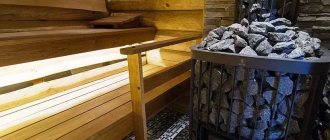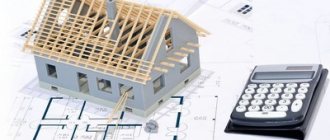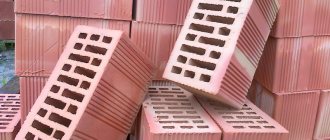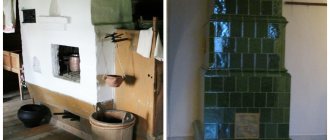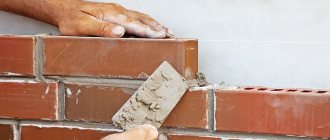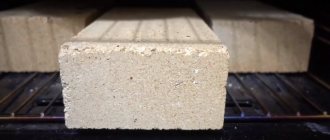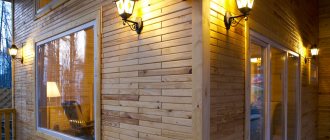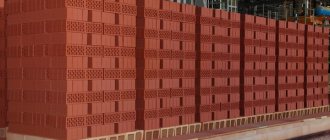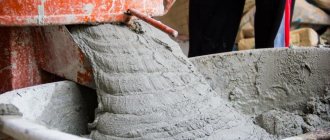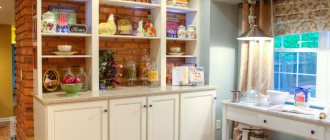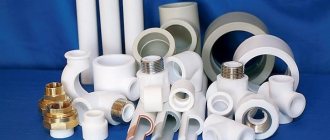Features and advantages of the material
Construction porous brick is a modern wall material with excellent performance and consumer characteristics. It is ideal for low- and high-rise buildings, while combining all the qualities of red hollow brick and aerated concrete blocks.
Porous ceramic block LSR 10
The material was originally invented in Australia and later spread throughout the world. In recent years, “warm ceramics” have been increasingly used in construction.
Important! Externally, porous brick differs from ordinary brick in its porous structure, size, and low weight. Its thermal insulation properties are an order of magnitude higher, so serious savings in energy resources are observed in buildings and structures made from this material.
The composition may include both the main components (clay, peat) and various additives, so the price of porous brick varies depending on the specific manufacturer. In any case, it is lower than the cost of solid material, because the mixture consumption is much less.
Porous brick has many positive properties:
- Non-flammability. The building will be able to withstand fire for at least 7 hours without significant destruction.
- Great geometry. Each block turns out perfectly smooth, so a thin layer of mortar is enough for laying. In addition, the vertical joints of the blocks are connected using a tongue-and-groove system, which enhances the strength of the masonry. The masonry itself does not require additional reinforcement.
- Bioinertness. Bricks do not support the growth of fungi and mold.
- Vapor permeability. Thanks to this property, buildings made of such material will always have an optimal microclimate and condensation will not occur.
- Low density. Due to the presence of pores, the material turns out to be rarefied, therefore, its thermal conductivity coefficient is minimal.
- Light load on the foundation. Since the mass of the blocks is much lower than that of ordinary or sand-lime brick, you can use a more economical option for the foundation of the house.
- Soundproofing. Porous brick has excellent sound insulating properties.
- Environmental friendliness. The raw materials contain no harmful or toxic components.
General conclusions
As we can see, the thermal conductivity of warm ceramics is an extremely important parameter. However, in addition to this, other factors should be taken into account when choosing, including the climatic conditions of the region and the absence or presence of additional insulation or finishing with facing bricks. In general, all ceramic blocks are suitable for central Russia. However, if you do not want to use additional thermal insulation, then it makes sense to buy blocks with a thickness of 440mm or 510mm, or some varieties of 380mm blocks. If the future installation of an additional “thermal coat” does not bother you, then it is quite possible to get by with blocks for wall thicknesses of 250 mm and 380 mm, provided that you provide additional thermal insulation in the form of mineral wool or polystyrene foam, and decorative plaster. The advantage of this option is that a thinner foundation will be enough for you, which will reduce the costs and time of its construction.
Production technology
The main component for producing bricks is clay, from which all impurities, dirt, and small stones are removed in advance. Up to 25-30% of the total volume of raw materials consists of fillers: peat, sawdust, straw. During firing, all the filler will burn out, and pores will remain in its place.
After combining the filler with the base and additives, the mass is ground so that it becomes completely mixed and homogeneous. Then it is pressed and molded, and during these manipulations all excess air is released.
Using a steel string, bars are cut to the required size, which are sent to the workshop to dry for 60 hours. For large bricks, the drying time is increased to 70 hours.
Porous block production line
The final stage of production is firing. It can last up to 50 hours and is carried out in a special oven at a temperature of about +1000 degrees. The quality of the finished brick depends on the correct firing. Its strength will be quite high, all organic components will burn out completely, and the weight will become much less than it was at the beginning.
Characteristics of porous bricks
On sale you can find material of different sizes. The main types of “warm ceramics” by size:
- single – 25*12*6.5 cm;
- one and a half – 25*12*8.8 cm;
- double – 25*12*13.8 cm;
- construction – 25*25*13.8 cm;
- large-format porous 38*25.3*21.9 cm;
- large-format superporous 39.8*25.3*21.9 cm.
Large-format ceramic block Poromax-250
The dimensions of energy-efficient bricks are much larger than usual, which speeds up the time for masonry and reduces labor costs.
Important! Due to its significant size, it is possible to build thick walls, because one row of porous bricks will replace two rows of standard ones.
As a result, the walls will have few layers, there will be no cold bridges in them, and there will be no need to use insulation. Porous ceramics also differ in grades, which are designated by the letter “M” and reflect reliability under compression (from M-50 to M-200).
Construction of a wall made of warm ceramics
The number of voids inside the blocks can be different: their share is 14-35% of the total volume. The density of the material is small (700-800 kg/m³), but remains sufficient for its suitability in the construction of load-bearing walls.
Other important technical parameters of ceramics:
- Frost resistance. Reflects the number of freezing and thawing cycles that the product can withstand. Typically for porous ceramics this figure is 50 cycles. This does not mean that in 50 years the house will fall apart. We are talking about complete freezing of the blocks, which is only possible in an unused building.
- Water absorption. Compared to conventional ceramics, warm brick has a slightly increased water absorption rate (11-14%), this is due to its porosity. Problems can only begin when the material is completely immersed in water, which is almost never observed under standard conditions. To protect the brick, you can use its outer cladding, and install a vapor barrier inside wet rooms (baths, swimming pools).
- Thermal conductivity. It can be called unique (0.08-0.2 W/m²). The efficiency of such blocks is an order of magnitude higher, and heat loss is 2-3 times lower than that of houses made of solid brick and monolithic concrete. Porous ceramics have excellent storage capacity and naturally thermoregulate the air in the home.
Professional builders consider porous blocks to be quite fragile and difficult to transport. Indeed, they require well-thought-out conditions for pallet packing, transport, loading and unloading. However, high-quality products are strong and reliable, and all requirements for them are quite feasible.
Ceramic block format
The large format and lighter weight of the blocks mean not only lower thermal conductivity, but also ease of laying, an increase in the pace of construction, a reduction in the number of cold bridges, and a reduction in the consumption of masonry mortar. The dimensions of the blocks are directly tied to the size of a standard ceramic brick (250x120x65 mm) - this is the normal format or NF. And how many bricks one block replaces is shown by the digital value before the letter abbreviation. The size range starts from 2.1 NF blocks and ends with 14.3 NF blocks, but blocks of three formats are in greatest demand.
- 10.7 NF (38th), 380x250x219 mm.
- 12.4 NF (44th), 440x250x219 mm.
- 14.3 NF (51st), 510x250x219 mm.
In addition, they also produce additional blocks (corner blocks, for window and door openings), which make it possible to do without cutting when constructing a frame.
The large format and low thermal conductivity make it possible to use porous blocks without additional insulation, with cladding or a plaster facade. The choice of wall thickness is tied to the thermal resistance standards of enclosing structures, which vary depending on the region of construction - the colder it is, the better the walls should retain heat.
Ilya EfremovLead technical specialist
A single-layer wall made of a 380 mm ceramic block does not meet thermal conductivity requirements in the Moscow region, but two-layer masonry with a single facing brick already meets thermal requirements in the Moscow region. However, we recommend using a 440 mm block in the Moscow region, as this is the most optimal option for these conditions.
A 510 mm thick ceramic block is more often used in colder regions, as well as when constructing a plaster facade without the use of insulation. Accordingly, in the southern regions, ceramic blocks with a thickness of 380 mm are widely used.
And this is the opinion of not only the manufacturer; one of the “gurus” of the specialized threads on the forum on the topic of building ceramics also agrees with him.
NegativFORUMHOUSE Member
... If we consider modern construction, it makes sense to consider 12.35 NF stone and make masonry according to the standard, using light masonry mortar with good thermal engineering. A good solution gives low consumption (11 kg/12.35 NF) and heating technology comparable to a block (0.16). Complete plastering from the inside and external plastering of vertical joints gives an excellent result: we get a truly high-quality structure. For heating with main gas - an excellent option.
For walls with cladding, increasing the outer layer is not advisable; if there is a desire to increase thermal resistance, it is much more profitable to invest in additional insulation of the floors and better windows. The minimum possible thickness of ceramics, sufficient for all requirements and quite reasonable from the point of view of everyday comfort, is 300 mm + cladding.
Where is the material used?
Porous bricks are excellent for building walls of houses up to 9 floors high. Most often it is used in low-rise construction - for the construction of two- and three-story cottages.
The material is suitable for the construction of external walls, partitions, and load-bearing structures. It can also be used to make public buildings up to 24 m high, enclosing structures, and various buildings on a personal plot.
Partitions made of ceramic blocks
Warm ceramics have excellent technical and performance characteristics, so their demand in the construction industry is constantly growing.
